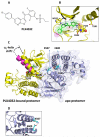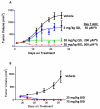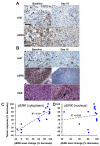Clinical efficacy of a RAF inhibitor needs broad target blockade in BRAF-mutant melanoma
- PMID: 20823850
- PMCID: PMC2948082
- DOI: 10.1038/nature09454
Clinical efficacy of a RAF inhibitor needs broad target blockade in BRAF-mutant melanoma
Abstract
B-RAF is the most frequently mutated protein kinase in human cancers. The finding that oncogenic mutations in BRAF are common in melanoma, followed by the demonstration that these tumours are dependent on the RAF/MEK/ERK pathway, offered hope that inhibition of B-RAF kinase activity could benefit melanoma patients. Herein, we describe the structure-guided discovery of PLX4032 (RG7204), a potent inhibitor of oncogenic B-RAF kinase activity. Preclinical experiments demonstrated that PLX4032 selectively blocked the RAF/MEK/ERK pathway in BRAF mutant cells and caused regression of BRAF mutant xenografts. Toxicology studies confirmed a wide safety margin consistent with the high degree of selectivity, enabling Phase 1 clinical trials using a crystalline formulation of PLX4032 (ref. 5). In a subset of melanoma patients, pathway inhibition was monitored in paired biopsy specimens collected before treatment initiation and following two weeks of treatment. This analysis revealed substantial inhibition of ERK phosphorylation, yet clinical evaluation did not show tumour regressions. At higher drug exposures afforded by a new amorphous drug formulation, greater than 80% inhibition of ERK phosphorylation in the tumours of patients correlated with clinical response. Indeed, the Phase 1 clinical data revealed a remarkably high 81% response rate in metastatic melanoma patients treated at an oral dose of 960 mg twice daily. These data demonstrate that BRAF-mutant melanomas are highly dependent on B-RAF kinase activity.
Figures




Comment in
-
BRAF inhibitor unveils its potential against advanced melanoma.Cancer Cell. 2010 Oct 19;18(4):301-2. doi: 10.1016/j.ccr.2010.10.001. Cancer Cell. 2010. PMID: 20951940
-
Cancer: Targeting mutant BRAF in metastatic melanoma.Nat Rev Drug Discov. 2010 Nov;9(11):841. doi: 10.1038/nrd3304. Epub 2010 Oct 29. Nat Rev Drug Discov. 2010. PMID: 21030999 No abstract available.
References
Publication types
MeSH terms
Substances
Associated data
- Actions
Grants and funding
LinkOut - more resources
Full Text Sources
Other Literature Sources
Medical
Research Materials
Miscellaneous

